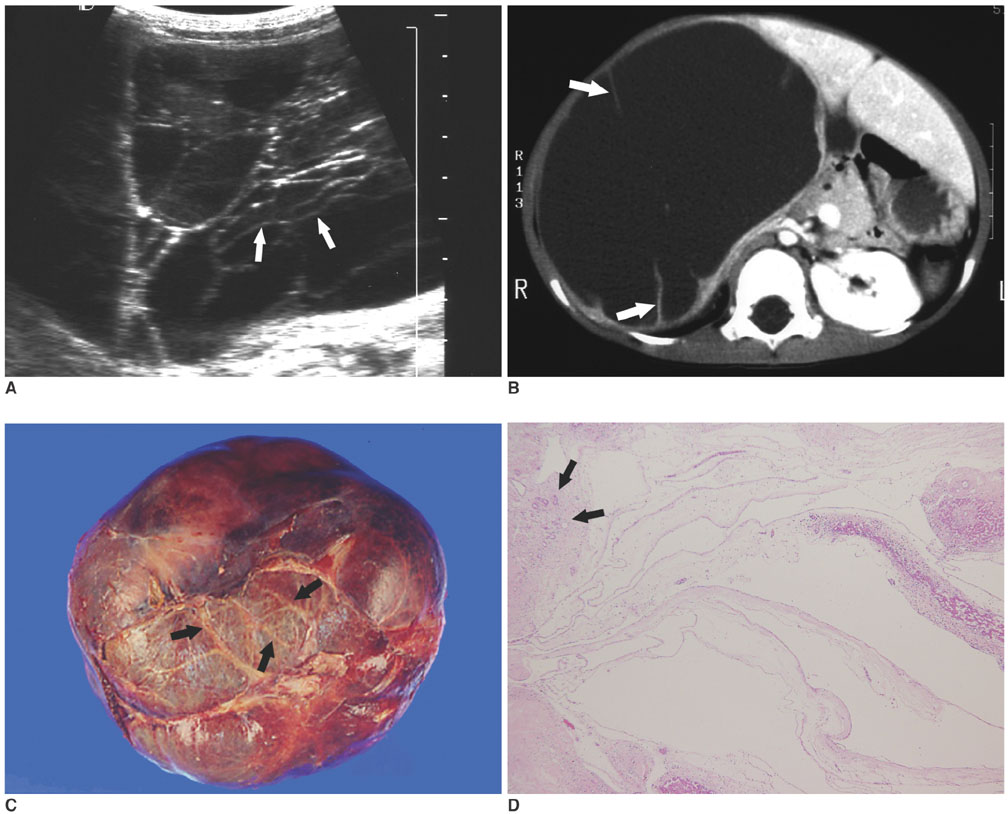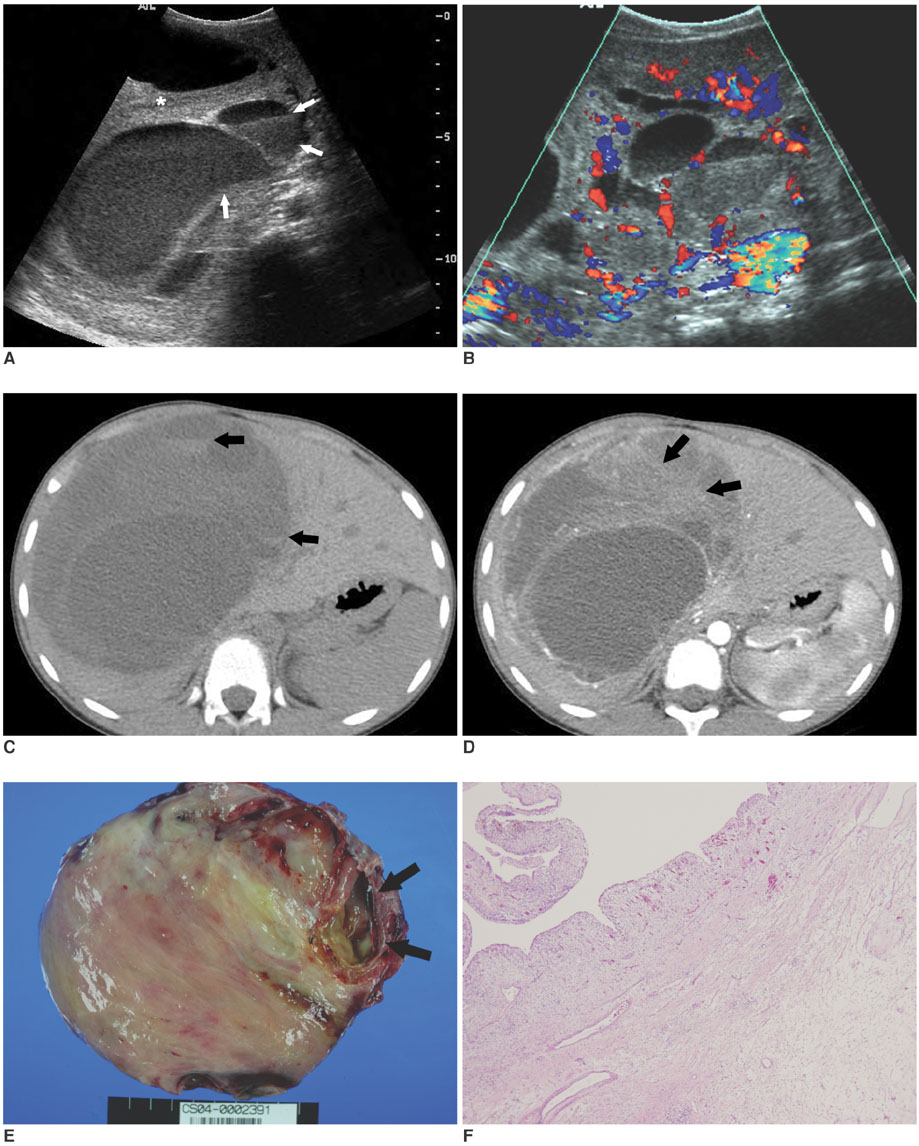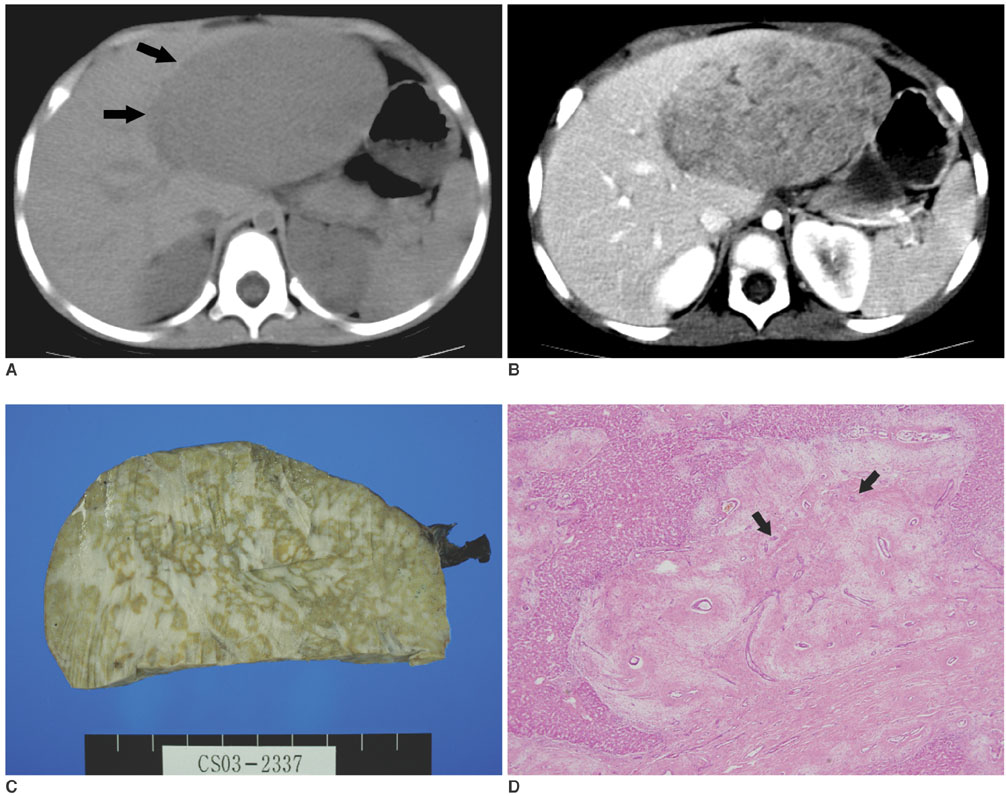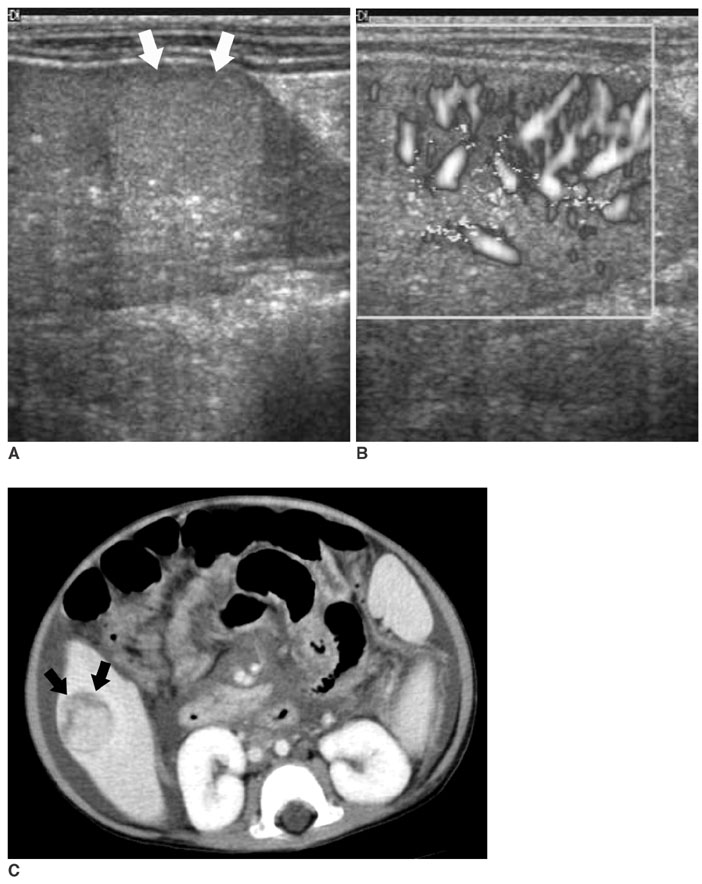Korean J Radiol.
2007 Dec;8(6):498-505. 10.3348/kjr.2007.8.6.498.
Radiological Spectrum of Hepatic Mesenchymal Hamartoma in Children
- Affiliations
-
- 1Department of Radiology, Seoul National University College of Medicine and the Institute of Radiation Medicine, SNUMRC, Seoul, Korea. kimws@radcom.snu.ac.kr
- 2Department of Radiology, Sanggye Paik Hospital, Inje University, Seoul, Korea.
- 3Department of Radiology, Samsung Medical Center, Sungkyunkwan University School of Medicine, Seoul, Korea.
- 4Department of Pathology, Seoul National University College of Medicine, Seoul, Korea.
- KMID: 1089437
- DOI: http://doi.org/10.3348/kjr.2007.8.6.498
Abstract
- OBJECTIVE: A hepatic mesenchymal hamartoma is an uncommon benign tumor in children and little is known about the spectrum of its radiological features. The purpose of this study is to describe the spectrum of radiological features of a hepatic mesenchymal hamartoma in children. MATERIALS AND METHODS: Thirteen children with a pathologically confirmed hepatic mesenchymal hamartoma (M:F = 7:6; mean age, 3 years 2 months) were included in our study. Ultrasonography (US) was performed in nine patients including color and power Doppler US (n = 7). CT scans were performed in all patients. We evaluated the imaging findings of the hepatic mesenchymal hamartomas and the corresponding pathological features. RESULTS: Each patient had a single tumor (mean diameter: 13 cm [1.8-20 cm]). On CT and/or US, four patients (31%) had a "multiseptated cystic tumor", five patients (38%) had a " mixed solid and cystic tumor", and four patients (31%) had a "solid tumor." The septa of the cystic portion were thin in the multiseptated cystic tumors and irregularly thick in the mixed solid and cystic tumors as seen on US. On a post-contrast CT scan, solid portions or thick septa of the tumors showed heterogeneous enhancement. The amount of hepatocytes was significantly different among the three tumor groups according to the imaging spectrum (p = 0.042). CONCLUSION: A hepatic mesenchymal hamartoma in children can show a wide spectrum of radiological features, from a multiseptated cystic tumor to a mixed solid and cystic tumor, and even a solid tumor.
Keyword
MeSH Terms
-
Child
Child, Preschool
Contrast Media/administration & dosage
Female
Hamartoma/*diagnosis
Humans
Infant
Liver/*radiography/ultrasonography
Liver Neoplasms/*diagnosis
Male
Mesoderm/*radiography/ultrasonography
Observer Variation
Radiographic Image Enhancement/methods
Retrospective Studies
Tomography, X-Ray Computed/methods
Ultrasonography, Doppler, Color/methods
Figure
Reference
-
1. Dehner LP, Ewing SL, Sumner HW. Infantile mesenchymal hamartoma of the liver. histologic and ultrastructural observations. Arch Pathol. 1975. 99:379–382.2. Stringer MD, Alizai NK. Mesenchymal hamartoma of the liver: a systematic review. J Pediatr Surg. 2005. 40:1681–1690.3. Ros PR, Goodman ZD, Ishak KG, Dachman AH, Olmsted WW, Hartman DS, et al. Mesenchymal hamartoma of the liver: radiologic-pathologic correlation. Radiology. 1986. 158:619–624.4. Federici S, Galli G, Sciutti R, Cuoghi D. Cystic mesenchymal hamartoma of the liver. Pediatr Radiol. 1992. 22:307–308.5. Stanley P, Hall TR, Woolley MM, Diament MJ, Gilsanz V, Miller JH. Mesenchymal hamartomas of the liver in childhood: sonographic and CT findings. AJR Am J Roentgenol. 1986. 147:1035–1039.6. Cetin M, Demirpolat G, Elmas N, Yüce G, Cetingül N, Balik E. Stromal predominant type mesenchymal hamartoma of liver: CT and MR features. Comput Med Imaging Graph. 2002. 26:167–169.7. Wada M, Ohashi E, Jin H, Nishikawa M, Shintani S, Yamashita M, et al. Mesenchymal hamartoma of the liver: report of an adult case and review of the literature. Intern Med. 1992. 31:1370–1375.8. Chung JH, Cho KJ, Choi DW, Lee BH, Chi JG. Solid mesenchymal hamartoma of the liver in adult. J Korean Med Sci. 1999. 14:335–337.9. Cook JR, Pfeifer JD, Dehner LP. Mesenchymal hamartoma of the liver in the adult: association with distinct clinical features and histological changes. Hum Pathol. 2002. 33:893–898.10. Edmondson HA. Differential diagnosis of tumors and tumor-like lesions of liver in infancy and childhood. AMA J Dis Child. 1956. 91:168–186.11. Helmberger TK, Ros PR, Mergo PJ, Tomczak R, Reiser MF. Pediatric liver neoplasms: a radiologic-pathologic correlation. Eur Radiol. 1999. 9:1339–1347.12. Stocker JT, Ishak KG. Mesenchymal hamartoma of the liver: report of 30 cases and review of the literature. Pediatr Pathol. 1983. 1:245–267.13. Alwaidh MH, Woodhall CR, Carty HT. Mesenchymal hamartoma of the liver: a case report. Pediatr Radiol. 1997. 27:247–249.14. Ito H, Kishikawa T, Toda T, Arai M, Muro H. Hepatic mesenchymal hamartoma of an infant. J Pediatr Surg. 1984. 19:315–317.15. Konez O, Goyal M, Vyas PK, Boinapally SB. Mesenchymal hamartoma of the liver. Comput Med Imaging Graph. 2001. 25:61–65.16. Chang HJ, Jin SY, Park C, Park YN, Jang JJ, Park CK, et al. Mesenchymal hamartoma of the liver: comparison of clinicopathologic features between cystic and solid forms. J Korean Med Sci. 2006. 21:63–68.17. Rhodes RH, Marchildon MB, Luebke DC, Edmondson HA, Mikity VG. A mixed hamartoma of the liver: light and electron microscopy. Hum Pathol. 1978. 9:211–221.18. Lack EE. Mesenchymal hamartoma of the liver. A clinical and pathologic study of nine cases. Am J Pediatr Hematol Oncol. 1986. 8:91–98.19. Okeda R. Mesenchymal hamartoma of the liver. An autopsy case with serial sections and some comments on its pathogenesis. Acta Pathol Jpn. 1976. 26:229–236.






